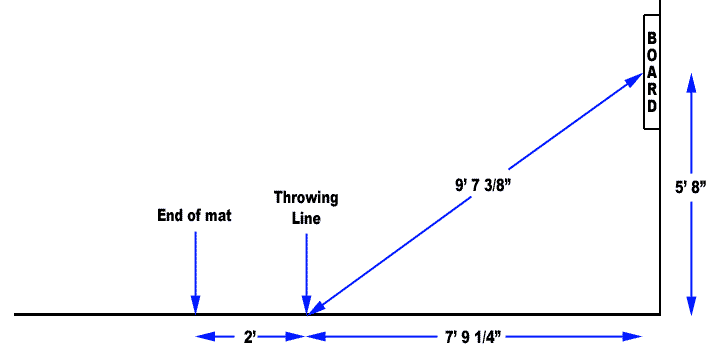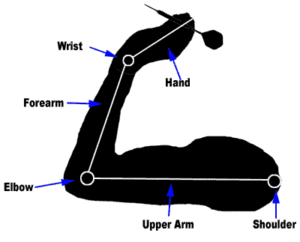Have you ever witnessed a game of darts on a professional level and wondered how to throw darts so perfectly like a pro? How can they hit their targets while making it look so easy?
In this guide, I will answer exactly this question. I will show you how to hang the dartboard, how to stand at the throw line (Oche), how to grip your dart, and finally how to throw darts consistently.
Buckle up!
Step 1 – Setting Up Your Dartboard Properly
Before you learn how to throw darts, you have to know how to set up your dartboard properly. Once you bought yourself a dartboard and are ready to hang it, there are standardized distances you have to follow while mounting your dartboard.
Here is how you do it …
From the floor to the center of the bull’s-eye should be 5 feet 8 inches. To find the throwing line, you measure 7 feet 9 ¼ inches from the front of the board. When you mount the dartboard, you want to make sure that the board is flush; it shouldn’t be leaning like a picture.
Also, the 20 should always be at the top. If you ever have to rotate your spider (due to wear) always make sure that the 20 is a dark color. Most dartboards should come with mounting instructions on how to attach your board to the wall. Make sure that you hang your board in a safe location. You will miss the board from time to time and darts will bounce off the board as well.
Never place a dartboard near windows or other breakables or where anyone could accidentally walk into the path of a flying dart.

Step 2 – How to Stand When Throwing Darts
Learning how to throw darts starts with your stance. Your stance at the throwing line is one of the most important aspects of throwing darts successfully. Your posture should allow your body to go through the throwing motion as smoothly as possible naturally. It should also be comfortable, give you stability and total balance. Those are the key elements to a successful dart stance and you have to make sure to master it if you want to learn how to throw darts like a pro.
There are two elements to your stance: your foot position and your position relative to the dartboard. You can pretty much break down foot positions into three groups: both feet perpendicular to the throw line, both feet facing the throw line, or both feet at a 45-degree angle to the line.
The important thing here is to find the position that you like best and stick with it. Before you settle on one, make sure you try a myriad of different stances.
Try altering the direction of your feet, and also spacing them until you find the one that is the most comfortable, as well as effective.
The other factor to consider for your stance is where you stand in relation to the dartboard. The majority of players stand so that the bull’s-eye is directly in front of their throwing arm when extended. It is best to not move between shots; consistency is the key here. Once you have found a stance that works for you, you will see a big improvement in your dart throwing ability.
There is no right or wrong way to hold a dart; the best way to hold the dart is the one that is the most effective for you.

Forward Stance
The forward stance is considered by some as the best position to take when you want to throw darts, but on the other hand, a lot of practice is required to make it perfect.
In this stance you place your dominant foot facing toward the dartboard, your toe should touch the throwline (oche) without exceeding it.
Don’t forget to have the right weight distribution, with 75% of your body weight on your dominant foot (leading foot). The less-dominant foot is used for balancing, it can have a slight angle to the side and be placed behind you, this can somehow give you more freedom when leaning forward to be closer to the board.
Just keep in mind, that when you assume this stance you should always be comfortable and have a good balance

The main critic that is given to this stance is that it increases the distance to the board and doesn’t tolerate a lot of leaning forward.
However, this stance is ideal for beginners due to its simplicity. So if you are a beginner who wants to learn how to throw darts consistently, I would recommend starting with the forward stance.
Side Stance
Angled Stance
Step 3 – How To Throw Darts With Precision
In order to perfect your dart throwing, we should look at the mechanics of the throw first. Darts will fly on a parabolic curve when you throw them; this is the same curve that a baseball or bullet would follow. The arc of the curve is determined by the force of the throw. The harder you throw the dart the shallower the curve.

To learn how to throw darts consistently, we have to apply this knowledge to our throw. We also need to understand how our arms work when we throw a dart. The best way to do this is to think of your arm as a machine. This machine is made up of three levers (your hand, forearm, and upper arm), these three levers are attached by joints (your wrist and elbow) and at the end of this machine is another joint attaching the machine to a fixed point (your shoulder). Below is a picture of this machine.

Now if you have any mechanical engineering in your background, you will know that with a machine like this it is possible to draw any possible curve within the range of the machine. Now let’s see how the arm looks in motion when you are actually throwing the dart.

Let’s take a closer look at this animation together because it’s very important.
Notice how in the animation the shoulder does not move?
When you are throwing, the only part of your body that should be moving is your arm. Moving down the arm we come to the elbow. Notice how the elbow doesn’t move much in the beginning phase of the throw but starts to move up during the acceleration phase. This is very important to keep our arm moving along the curve. If we tried to keep the elbow stationary, we would be forced to release the dart earlier.
By moving the elbow during the throw, it enables us to guide the dart along the curve for a longer period of time increasing our accuracy.
Finally, we come to the wrist. In this animation, the wrist doesn’t do much, and your wrist doesn’t have to do much for a good and proper throw. Many players do use more wrist in their throws though; this is for accelerating the dart. By using a snap of the wrist for acceleration, it means that you can slow down the rest of the motions and thereby increase accuracy. This is the basis for those wishing to learn how to throw darts with precision.
Beginners should be cautious though. While many pros and experienced players do use the wrist for accelerating the dart, it can be a dangerous thing because it is one more thing that you have to control. By allowing the arm to do most of the work you may be better off. The best advice is to begin by letting the arm do the work; this will really help you get used to the motions involved. Once you are doing well, then try adding more wrist acceleration in little by little.
The different phases of the throw are marked in the animation.
The phases are:
- aim
- cock
- accelerate
- release
- follow-through
Aiming is fairly self-explanatory. Line up the area on the board that you want to hit with the dart and then the dart with your eyes so that all three are in a line. You want your focus to be on the board and not on the dart. The cock, this is where you ready your arm for the throw, think of it as pulling back the string on a bow. You want to do this slowly, no need to rush it. The cock is important because the further you pull back the longer you will have to move the dart along the parabolic curve.
The further you pull back, the more space you have for the acceleration phase. The important part of the acceleration phase is to do it as smoothly as possible and not too fast. There is no need to send the darts flying at warp speed; you only want to use enough power to make the dart penetrate the board. The harder you throw the dart the more likely you will mess up. Don’t forget to slightly raise your elbow during the acceleration phase so that you can keep your arm on the curve for as long as possible. You want to keep the motion from the acceleration phase all the way through both the release and the follow-through.
The release phase is probably the part that comes most naturally, just do it as smoothly as possible and don’t try and do anything fancy like spin the dart, just gently release the dart and keep it on the curve. The final phase is the follow-through and it definitely shouldn’t be overlooked. Your follow-through should keep your arm on the same arc as your throw; if you can do this, you will have no problem mastering the follow-through.
Now You Know How To Throw Darts
That about wraps up how to throw darts, a little more complicated than it first seems but with practice it will become second nature. The best way to improve your throw is to practice and then practice some more. Good luck!
Recommended Reading
Dart Games 301 and 501 (Rules, Scoring, Strategies)
If you're looking for Darts 301 501 rules and scoring, then this comprehensive guide is the answer!
How to Play Cricket Darts (Rules, Scoring, Strategies)
Learn all about cricket darts and how you can play this fun game. This blog covers the rules, scoring as well as strategies to win!
The Ultimate Home Dartboard Setup (Step-by-Step Guide)
Following these 5 steps, you can make your own home dartboard setup that you have always wanted.
How To Play Baseball Dart Game (Rules, Scoring, Strategy)
Wondering how to play baseball dart game? Check out this article to learn about the rules, scoring and the best strategy!
75 Darts Terms You Should Know (Full Darts Glossary)
This is the ultimate darts glossary that consists of 75 different darts terms and slang that you should know if you want to take it to the next level.
“Bellies And Bullseyes” by Sid Waddell (Book Review)
This is the review of Sid Waddell's book called "Bellies and Bullseyes: The Outrageous True Story of Darts".
